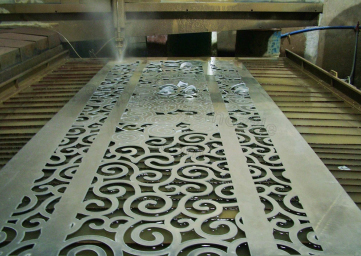
1. Water cutting and laser cutting
Laser cutting is a manufacturing method to increase productivity, and of course it also has its uses. And water cutting is indeed better than laser in some aspects:
a. There is no restriction on cutting thickness;
b. Reflective materials such as brass and aluminum can also be cut;
c. There is no need to invest in heat energy, so it will not burn or produce thermal effects;
d. When you change the cutting material, the only thing you need to change is the cutting speed; there is no need to change the gas, focus or other objects;
e. It is easy to install more cutting heads to increase productivity.
f. The maintenance of laser equipment is more professional and difficult;
g. You can have a complete set of water cutting equipment at the price of 1/2 to 1/3 of the purchase of laser equipment.
2. Water cutting and milling cutting
If you want to cut the periphery of the workpiece and punch holes, instead of using blind holes, drilling and threading methods, it is better to choose a sand knife that is faster, easier to arrange and cheaper. The main reason is that we only need one water cutting process to complete the cutting of the workpiece, instead of grinding all the metal into pieces. When it is necessary to cut high-precision workpieces, the sand knife is a machine tool that can be used to produce close to the finished product, which can be processed in one time without generating thermal effects. In addition, the waste produced by the sanding knife is usually more valuable because it is in the form of a whole piece rather than scraps and can be reused.
3. Water cutting and arc and flame cutting
Obviously, Plasma is a thermal processing process that will produce a thermal effect on the finished product. However, the surface treatment of the sand knife is usually better, and there will be no scum on the back of the workpiece, which can reduce the secondary processing. Sand knife cutting has no thickness limitation, and the layout spacing of cutting graphics can be reduced to save material costs.
4. Comparison of water cutting and laser cutting
The investment of laser cutting equipment is relatively large, most of which are used for the cutting of thin steel plates and some non-metallic materials. The cutting speed is faster and the accuracy is higher. However, the laser cutting will cause arc marks and heat effects at the cutting seam; in addition, for some materials Laser cutting is not ideal, such as aluminum, copper and other non-ferrous metals, alloys, especially for the cutting of thicker metal plates, the cutting surface is not ideal, or even impossible to cut. People's research on high-power laser generators is trying to solve the cutting of thick steel plates, but the cost of equipment investment, maintenance and operation consumption is also considerable. Water cutting has low investment, low operating cost, wide range of cutting materials, high efficiency, and convenient operation and maintenance.
5. Water cutting and plasma cutting
Plasma cutting has obvious thermal effect, low precision, and it is not easy to perform secondary processing on the cut surface. Water cutting is cold cutting, no thermal deformation, good quality of the cutting surface, no secondary processing, and easy secondary processing if necessary.
6. Water cutting and wire cutting
Wire cutting is very accurate but the cutting speed is very slow, it requires conductive materials and will produce thermal effects. For metal processing, wire cutting has higher precision, but the speed is very slow. Sometimes other methods are needed to punch and thread to cut, and the cutting size is very limited. Water cutting can punch and cut any material , Fast cutting speed, flexible processing size.